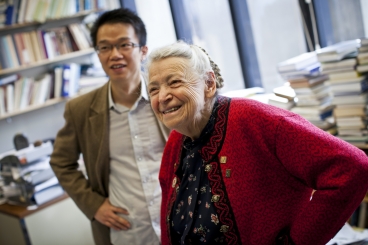Graphene has been extensively researched for its unusual mechanical, optical and electronic characteristics.
 "PhD candidate Shuang Tang, left, and Institute Professor Mildred Dresselhaus"
"PhD candidate Shuang Tang, left, and Institute Professor Mildred Dresselhaus"
Now, scientists from Massachusetts Institute of Technology (MIT) have discovered another compound that exhibits most of the graphene’s properties and in certain cases displays complementary characteristics.
The new material is a thin bismuth-antimony film that can exhibit a range of varied controllable properties. The scientists discovered that the thickness of this material and the direction of its growth rely on pressure and ambient temperature. The study was published in Nano Letters.
Similar like graphene, the novel material has electronic characteristics called 2D Dirac cones, which are referred to the cone-shaped graph that plots momentum against energy for electrons traveling across the material. These characteristics may impart unique properties to the bismuth-antimony films, and these properties can be applied in developing advanced coolers, thermoelectric generators and electronic chips.
PhD candidate, Shuang Tang informed that electrons can move as a beam of light in such type of materials and this makes it possible to develop chips with faster computational abilities.
In thermoelectric applications, the combination of faster electron movement and robust thermal insulating properties may result in efficient power generation and may be handy in powering satellites. However, such applications are still tentative at this stage and more research is required to study the material’s additional properties.
While the new material shares some of the graphene’s properties, conditions can be modified to promote a range of other properties. This may help in developing electronic devices from the same material with different properties, for instance, depositing one layer over another, instead of having different material layers.
Source: http://www.mitindia.edu/